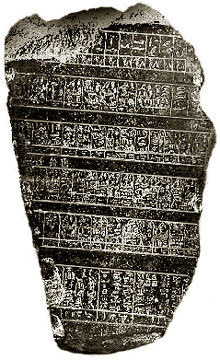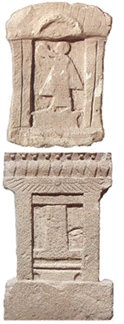...Best of Sicily presents... Best of Sicily Magazine. ... Dedicated to Sicilian art, culture, history, people, places and all things Sicilian. |
by Carlo Trabia | |||
Magazine Index Best of Sicily Arts & Culture Fashion Food & Wine History & Society About Us Travel Faqs Contact Map of Sicily
|
Housed in the Salinas Regional Archaeological Museum in Piazza Olivella in central Palermo, the Palermo Stone is a stela (inscribed upright stone slab bearing an inscription) carved from black basalt. It superficially resembles the Rosetta Stone, which is chiefly a linguistic key. The significance of the Palermo Stone lies in its being a record of some of Egypt's earliest dynasties. The stone was probably engraved during the last years of the Fifth Dynasty or the period immediately afterward. Thus dated to around 2420 BC (BCE), it is the oldest surviving historical text of ancient Egypt and was probably the basis of subsequent histories and chronologies, including that of Manetho. The hieroglyphics list the kings until the time of Menes (circa 3000 BC), specifically his more important predecessors, the earliest of whom are the quasi-mythical "god-kings." Menes is sometimes credited with uniting Egypt, but the Palermo Stone suggests that the region may originally have been united long before his reign, implying that he reunited it following a period of chaos. Nevertheless, the stone's engravings state that Menes received the throne from the god Horus, who is just one of the numerous deities mentioned. In addition to this chronology, it mentions specific events, such as the height of the Nile during flooding, taxation, religious festivals, military activity and even certain buildings. Details such as donations to the temples are also featured, mentioning land, cattle and agriculture. The hunting of hippos is noted in the annals of the First Dynasty. The smelting of copper to make statues, indicated as early as the Second Dynasty (beginning 2890 BC), is useful in precisely ascertaining the earliest phase of the Bronze Age. Records such as this are best interpreted in corroboration with others, such as the "Royal Canon" of the Turin Papyrus, useful for dates beginning a thousand years later than the period of focus of the Palermo Stone --a reminder that the various kingdoms of Egypt existed, in one form or another, for an era spanning more than three millennia, until the Roman domination. Corroboration is not limited to documentary evidence; identifying actual buildings with those mentioned in the inscriptions is also important. Continuity is the whole point behind this unique chronicle, written to
legitimise Menes' own Fifth Dynasty as legitimate successor to older historical dynasties and
even gods. Thus it is unsurprising that Menes would assert that his throne
was a direct gift from Horus. As the references recede into antiquity, their
literal accuracy probably lessens, though the inscriptions almost certainly
reflect earlier ones lost to time. A good case could be made Inscribed on both sides, the piece of the stone in Palermo is only a fragment of the original stela. Other pieces are displayed in the Cairo Museum and the Petrie Museum (London). Discovered near Memphis in 1866, the Palermo Stone ended up in Sicily en route to London. Only in 1895 was it found in Sicily, and its importance noted, by an archaeologist visiting from France. In fact, it had been kept by a Sicilian family in their home, where it was actually used as a door mat. (This certainly seems to support the thesis that until recently Sicily was not the most appropriate place to preserve antiquities, whether Sicilian or foreign.) The first published information regarding the Palermo Stone was the study of Heinrich Schafer, in 1902. While the Palermo Stone lacks a connection to ancient Sicilian history per se, as Sicily was beyond the western frontier of Egypt, it is important to acknowledge that the culture brought to Sicily by the Phoenicians circa 800 BC was influenced by Egypt's, a fact reflected in Phoenician art (such as the stelae from Mozia shown here) and mythology (the cult of the goddess Isis). The inscriptions are, of course, important in establishing the early history of the societies of the eastern Mediterranean, which in turn form the groundwork of those - such as the civilisations of Asia Minor (probably via the Elymians), Greece and Phoenicia - that contributed much to the cultural fabric of ancient Sicily. About the Author: Architect Carlo Trabia has written for this publication and others. | ||
Top of Page |
 Overshadowed by its much younger "sister" archaeological find
(the Rosetta Stone) in London's British Museum, the Palermo Stone is often
regarded outside scholarly circles as a mere footnote to ancient Egyptian
history. It is, in fact, much more important than its reputation might imply.
Overshadowed by its much younger "sister" archaeological find
(the Rosetta Stone) in London's British Museum, the Palermo Stone is often
regarded outside scholarly circles as a mere footnote to ancient Egyptian
history. It is, in fact, much more important than its reputation might imply. for the Palermo
Stone being the oldest written historical record in the world to have been
definitively dated and completely interpreted.
for the Palermo
Stone being the oldest written historical record in the world to have been
definitively dated and completely interpreted.